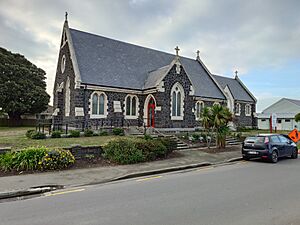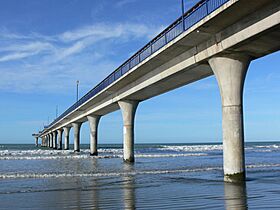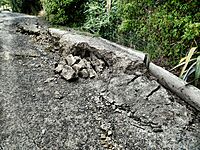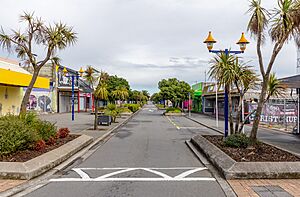New Brighton, New Zealand facts for kids
Quick facts for kids
New Brighton
|
|
|---|---|
|
Suburb
|
|
| Country | New Zealand |
| Local authority | Christchurch |
| Electoral ward | Coastal |
| Area | |
| • Land | 370 ha (910 acre) |
| Population
(June 2023)
|
|
| • Total | 6,200 |
|
|
||
New Brighton is a lively coastal town in Christchurch, New Zealand. It's about 8 kilometers (5 miles) east of the city center. New Brighton is famous for its unique pier and beautiful beaches. It's a popular spot for fun and tourism in eastern Christchurch. However, the area was badly affected by the 2011 Christchurch earthquakes.
Contents
History of New Brighton
Māori Connections to the Land
New Brighton is very important to the local Māori tribe called Ngāi Tahu. They are the traditional guardians, or kaitiaki, of this land. A special group within Ngāi Tahu, called Ngāi Tūāhuriri, has the main rights to this area. The wider coast, including New Brighton, is known as Te Tai o Mahaanui.
The first Māori people arrived in Canterbury around the 13th century. However, Māori family histories, called whakapapa, suggest they were there even earlier. The South Island was discovered by the Waitaha ancestor, Rākaihautū.
Traditional places for gathering food, known as mahinga kai, were used by the Waitaha, Rapuwai, Kāti Mamoe, and later Ngāi Tahu tribes. One important spot was Ihutai, which is the Avon Heathcote Estuary near New Brighton. Walking paths between Ngāi Tahu settlements, or kāika, passed close to where New Brighton's shops are today. A sand dune track called Pohoareare ran along Ihutai. It connected the Ōpāwaho kāika on the Heathcote River to New Brighton. This was a popular place for swimming and catching horihori (sole fish).
How New Brighton Got Its Name
The name "New Brighton" was chosen quite suddenly by William Fee, an early settler. In December 1860, Guise Brittan, a land official, visited the area. When he was recognized, Fee quickly wrote "New Brighton" on a wooden plank. He supposedly named it after his friend Stephen Brooker, who came from New Brighton in England. People often call the suburb just "Brighton." This can sometimes cause confusion with Brighton, a town near Dunedin.
Early European Settlement
The first European home in the area was built in 1858 by a man named Walker. From 1860 onwards, more and more settlers became interested in New Brighton. The first houses were simple, made from mānuka scrub and clay. These "cob and sod" homes often had one large room, a clay floor, and an oil drum for cooking.
Early settlers faced challenges like a lack of roads and the sandy landscape. Strong winds could cover the rough roads with a foot of sand. To stop the sand from moving, people planted vegetation. After trying many types of grass, they found that lupins and marram-grass worked best. By 1899, officials had planted a ton of marram-grass.
One of the first people to see potential in New Brighton was Joseph Harrop Hopkins from England. In 1872, he bought 150 acres of land for £300. Within two years, Hopkins built a boarding house and a hotel. In 1874, the hotel was officially named "New Brighton." To attract visitors, Hopkins bought a large 170-passenger paddle steamer. It ran daily from central Christchurch to New Brighton. However, the steamer didn't bring in enough visitors, and Hopkins faced money problems. In 1875, he had to sell the steamer and his land.
New Brighton grew slowly at first. By 1884, there were only 16 houses. From 1885, the number of houses slowly increased. Roads were planned, and the first shops appeared. The area used to be known simply as "the Beach." It was part of the Avon River Road Board District. As it grew, New Brighton became a borough (a type of town) in 1897. By 1901, it had 1,008 residents. This number grew to about 4,000 by 1922.
Transportation in New Brighton
Early Roads and Travel
Before proper roads, getting to New Brighton was difficult. The area was separated from Christchurch by swampy land near the Avon River. Later, as the city grew, land was drained and filled, connecting New Brighton to Christchurch. Early European settlers used ox-drawn carts to carry goods. They often laid mānuka scrub on the ground to stop carts from getting stuck in the mud. The first road followed the Avon River.
In 1874, the poor quality of the roads was a big problem because of the moving sands. People asked the Canterbury Provincial Council for money to improve them. Road maintenance depended on the borough's income. From 1897, a water cart was used on dirt roads to keep dust down. In 1896, gravel began to be laid on some roads.
Public Transport Begins
In 1861, the first commercial coach service started. By 1872, daily coach services from Christchurch began. This encouraged more people to settle in the area, building boarding houses, holiday homes, and permanent houses.
Trams in New Brighton
Trams first came to Christchurch in 1880. The Canterbury Tramway Company started them. Seeing this success, the New Brighton Tramway Company was formed in 1885. Their goal was to connect the central Christchurch tram network to New Brighton. Construction of the line, which followed Pages Road, began in 1887 and finished early the next year. Services started on February 15, 1888. This tram service was very popular, carrying between 3,000 and 5,000 passengers each week.
A second tram route, called the North Beach tramline, was built by the City and Suburban Tramway Company. It passed through several suburbs before ending at the New Brighton Pier in 1894.
In these early days, both tram routes used horses to pull the trams. In 1905, the Christchurch Tramway Board took over the tram companies. They introduced steam engines to the New Brighton lines. The tram lines in New Brighton were fully electric by August 1906.
Trolley Buses and Diesel Buses
Over time, the North Beach tram route became too expensive to run. The tracks were in poor condition, and trams couldn't compete with private buses. In 1931, the tramline closed. An electric trolley bus service started in its place. The bus company was bought by the Board in 1935, giving them control of that route.
The main New Brighton tramway line was affected by the economy. During the Great Depression in the 1930s, fewer people rode the trams. But during World War II, ridership increased because other transport was limited. By the late 1940s, with Christchurch growing and more people owning cars, trams were no longer the best public transport option. Between 1947 and 1951, the Christchurch Transport Board decided to replace trams with diesel-powered buses.
The change from trams to buses happened quickly in 1951. The Board ordered 57 diesel buses. Their routes followed the old tram and trolley bus networks. The Christchurch-New Brighton tram line closed on October 18, 1952. The 5 Brighton bus route, following the same path along Pages Road, started the same day. Buses allowed for new routes, including 5A Aldwins Road, 5B Breezes Road, and 5S South Brighton. The 10 Marshland Road and Richmond bus service, which connected to the North Beach route, started in 1956. The 19 North Beach bus service, which followed the old North Beach tram and trolley bus route, also began in 1956.
In 1984, two new services, the 30 & 31 Seaside Specials, were introduced. These brought people from the southern and northern suburbs to New Brighton for Saturday shopping. When shops started opening on weekends generally, these special bus services were no longer needed and were stopped.
Today, New Brighton is served by several bus routes under the Metro brand:
| # | Route Name | Start | Major destinations | End | Notes |
|---|---|---|---|---|---|
| 5 | Rolleston/New Brighton | The Hub Hornby or
Rolleston via Templeton |
Church Corner, Riccarton Mall, Christchurch Hospital, Bus Interchange, Fitzgerald Avenue, Eastgate Mall | New Brighton | |
| 5x | Rolleston/New Brighton | Rolleston | Templeton, Hornby Hub, Church Corner, Riccarton Mall, Christchurch Hospital, Bus Interchange | Ara Institute | Weekdays only |
| 60 | Hillmorton – Southshore | Wigram | Aidanfield, Hillmorton, Barrington Mall, Christchurch Hospital, Bus Interchange, The Palms Mall, Travis Road, New Brighton | Southshore | |
| 135 | New Brighton – The Palms | New Brighton | New Brighton, Taiora QE II, Burwood Hospital, Prestons, The Palms | The Palms | No Sunday service |
New Brighton After the Earthquakes
Because of the type of ground it's built on, New Brighton was heavily impacted by the 2011 earthquakes. The damage wasn't just to buildings.
In December 2012, residents held a protest because they felt rebuilding was too slow. Christchurch Mayor Bob Parker said he understood their frustration. Many people in New Brighton continued to feel that the Christchurch City Council wasn't investing enough in their area. Paul Zaaman, a local business spokesperson, even formed "The People's Independent Republic of New Brighton" to highlight this issue.
New Brighton was chosen as the finish line for the annual Coast to Coast multisport race in February 2015. Before this, the race ended in Sumner. There were plans to redevelop the town center after the earthquakes, but as of 2022, this hasn't fully happened.
Location of New Brighton
New Brighton is divided into three parts along the southern coast of Pegasus Bay: North New Brighton, New Brighton, and South New Brighton. South New Brighton is at the northern end of a narrow strip of land between the bay and the Avon Heathcote Estuary. A 300-meter (980 ft) pier was built here in the 1990s and opened on November 1, 1997.
New Brighton was once a separate coastal village. It was cut off from Christchurch's outer suburbs by swampy areas near the Avon River. However, as Christchurch grew, land was filled in and drained. This connected New Brighton directly to the city.
Population and People
New Brighton covers about 3.70 square kilometers (1.43 sq mi). It has an estimated population of 6,099 people as of 2023. This means there are about 1,648 people per square kilometer.
At the 2018 New Zealand census, New Brighton had 6,099 residents. This was a small increase of 153 people (2.6%) since the 2013 census. However, it was a decrease of 498 people (7.5%) since the 2006 census. There were 2,544 households. The population included 3,018 males and 3,084 females, meaning there were slightly more females. About 1,134 people (18.6%) were under 15 years old.
Most residents (88.7%) were European/Pākehā. Other groups included 14.2% Māori, 4.0% Pasifika, 3.4% Asian, and 2.5% other ethnicities. Some people identified with more than one ethnic group. About 18.5% of people were born overseas, which is lower than the national average of 27.1%.
When asked about religion, 59.7% said they had no religion. About 27.1% were Christian. Smaller numbers followed Māori religious beliefs, Hinduism, Islam, Buddhism, or other religions.
Of those aged 15 or older, 846 people (17.0%) had a university degree or higher. About 1,065 people (21.5%) had no formal qualifications. Around 567 people (11.4%) earned over $70,000 a year. This is less than the national average of 17.2%. For employment, 2,454 people (49.4%) worked full-time. Another 708 (14.3%) worked part-time, and 234 (4.7%) were unemployed.
| Name | Area (km2) |
Population | Density (per km2) |
Households | Median age | Median income |
|---|---|---|---|---|---|---|
| New Brighton | 1.76 | 3,330 | 1,892 | 1,431 | 39.5 years | $29,800 |
| Rawhiti | 1.94 | 2,769 | 1,427 | 1,113 | 37.5 years | $30,000 |
| New Zealand | 37.4 years | $31,800 |
Economy and Development
For many years, New Brighton was special because it was the only place in Christchurch where shops could open on Saturdays. This made its business area very busy. However, when Saturday trading became allowed nationwide in 1980, and then seven-day trading in 1990, retail activity in New Brighton dropped a lot.
The 2011 Christchurch earthquakes made New Brighton's economic struggles even worse. Many empty, damaged sites appeared in its main shopping area. To help New Brighton recover, the Beachside Playground was improved. Also, the He Puna Taimoana saltwater hot pools were built as part of the New Brighton Regeneration Project.
New housing projects are also being planned. For example, Williams Corporation sold 37 townhouses on Marine Parade in just 24 hours in March 2022. The Home Foundation is building over 60 terraced homes in a project called Te Pakau Maru on Beresford Street. Paradigm Group plans to build shops on the ground floor and 16 apartments above them at the empty site of 101 Brighton Mall.
Famous Places in New Brighton
New Brighton Pier
The first New Brighton pier opened on January 18, 1894, by the Governor of New Zealand. This 180-meter (590 ft) long wooden pier took three years to build. Its opening was a big step in making New Brighton a popular health and recreation spot. Some people believe New Brighton never fully reached its potential as a resort, possibly due to strong winds, poor soil, and the suburb's somewhat worn-out image. The first pier stood until 1965 when it was taken down because the City Council decided it was no longer safe.
A new 300-meter (980 ft) long concrete pier was built and opened on November 1, 1997. In 1999, a library and cafe building were added at the pier's base. This building won awards from the New Zealand Institute of Architects. The pier was closed for earthquake repairs in 2016 and reopened in May 2018. It has now become one of Christchurch's most recognizable landmarks.
St Faith's Anglican Church

St Faith's is an Anglican church located on Hawke Street. The first church building, made of wood, was built in 1886 and made larger in 1909. The current church was built between 1924 and 1925. It was constructed using basalt stone from the Port Hills, a slate roof, and Oamaru stone for decorations and inner walls. The church was badly damaged in the 2010 and 2011 Christchurch earthquakes. After a lot of work to repair and strengthen the building, it reopened in May 2022.
Schools in New Brighton
New Brighton has two high schools located next to each other: Shirley Boys' High School and Avonside Girls' High School. It also has three primary schools:
- New Brighton Catholic School: This is a state-integrated primary school for students in years 1 to 8. It was started in 1935.
- Nova Montessori School: This is a private primary school for years 1 to 8. It was established in 1988.
- Rāwhiti School: This is a state primary school for years 1 to 8. It opened in January 2015 after three schools (Central New Brighton, Freeville, and North New Brighton schools) joined together.
The suburb also has several kindergartens and childcare centers, including the New Brighton Community Preschool and Nursery.
Sports and Fun Activities
Rāwhiti Domain is the main sports field in New Brighton. It has facilities for the New Brighton Rugby Football Club and the New Brighton Olympic Athletic Club. The suburb also has a bowling club, which is located at the Returned Services' Association building.
The New Brighton Surf Bathing and Life Saving Club is the oldest surf life saving club in New Zealand. It was founded in July 1910.
Images for kids











